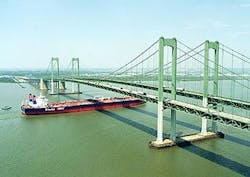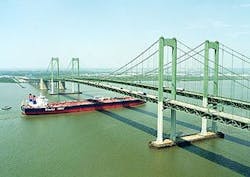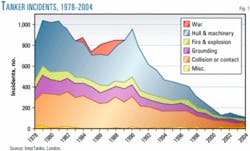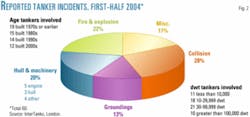Data compiled and published last month by Intertanko, the international association of independent tanker owners, suggests the trend in tanker incidents per year since 2001 has stabilized at a level well below the average annual number of incidents reported 1990-2000.
Average number of annual incidents since 2001 was about 120-150/year, less than a third of the average annual number 1990-2000.
Intertanko said it had recorded 60 tanker incidents during first-half 2004, most minor with no pollution or loss of life. This compares with 130 tanker incidents reported for all of 2003 (Fig. 1).
The Stena Vision glides under the Commodore Barry Bridge on the Delaware River south of Philadelphia, Pa. The VLCC is under long-term contract to Sunoco Inc. to bring West African oil to its Philadelphia-area refineries. Built in 2001 at shipyards of Hyundai Heavy Industries, Korea, the vessel can carry more than 2.25 million bbl. Photograph from Stena Bulk AB, commercial operator of the vessel, and taken by Conny Wickberg.
2004 Incidents
The biggest pollution incident during first-half 2004, said the association, was the 200 tonnes oil lost from the Everton in March off the Gulf of Oman. The vessel was carrying 80,400 tonnes of crude oil in when it caught fire and was abandoned by its crew.
Intertanko said the oil appeared to have been mainly burned up with one crewman reported missing.
The other pollution incidents recorded were very minor, it said.
As in 2003, the most serious tanker incidents thus far in 2004 have involved fire and explosion (Fig. 2). Intertanko reports that 44 people have either been killed or are missing. Of these, 21 were aboard the Singapore-flagged 1982-built chemical tanker Bow Mariner when it exploded and sank in 264 ft of water in late February 50 miles off Virginia while en route from New York to Texas City with a cargo of 11,000 tonnes of ethanol (OGJ, Mar. 8, 2004, p. 9).
In other 2004 incidents:
- Seven people were killed when fire swept through the 1993-built suezmax Almudaina when undergoing repair at Singapore's Keppel shipyard.
- Seven fishermen were missing after their boat was hit by the Chinese 1993-built panamax crude oil tanker Da Qing 93.
- Three crew members were missing after an engine-room fire on the 1978-built panamax crude oil tanker Fair Mare when departing the Strait of Hormuz.
- An explosion occurred aboard the 10,048 dwt 2003-built chemical tanker Panama Serena loaded with benzene while bunkering at Porto Torres.
Causes
The share of fire and explosion as a cause among all reported incidents 1978-89 was 5-10%, 6-13% of all reported incidents 1990-99, and 9-22% of all reported incidents 2000-first-half 2004.
Of the fire and explosion incidents so far in 2004, reported Intertanko, one fire was reported to have started in a cabin, one in an electrical system, five in engine rooms, and one while the vessel was being repaired at a shipyard. Of the five explosions, one occurred during repairs, three happened in cargo or ballast tanks, and one took place while bunkering.
Incidents involving fire and explosion have increased to 22% (13 incidents) in the first half of 2004 from 14% (18 incidents) in 2003. Since 1999-2000, however, incidents involving collisions or contact and grounding have fallen every year to only 41% in the first half of 2004 from 58% in 2000, 55% in 2001, 54% in 2002, and 49% in 2003.
Intertanko noted that ABS, in its March 2004 review and analysis of ship accident databases 1991-2002, found that human error continues to dominate in maritime accidents. In particular, it said, lack of situation awareness and errors in situation assessment were factors in up to 70% of the recorded accidents attributed to human error. Fatigue and task omission are closely related to lack of situation awareness.
ABS also noted that, "considering the billion tonnes of material shipped on the high seas every year, the millions of miles of wake left behind, and the apparent infrequency of major accidents, shipping might be said to be a rather safe industry, generating a steadily declining trend in marine accidents leading to loss of property, life and environmental damage over the last decade."



